Hemionitis arifolia
Want a plant that makes a big statement without a big footprint? Then the heart fern is the pteridophyte for you.
Taking up less than a cubic foot of space at maturity with glossy, heart-shaped leaves, Hemionitis arifolia is an unusual yet stunning specimen.
Hailing from tropical regions of Southeast Asia, this evergreen plant has been used historically to treat diabetes and certain types of cancer in its native range. A fun piece of trivia for anyone who asks about it, wouldn’t you agree?
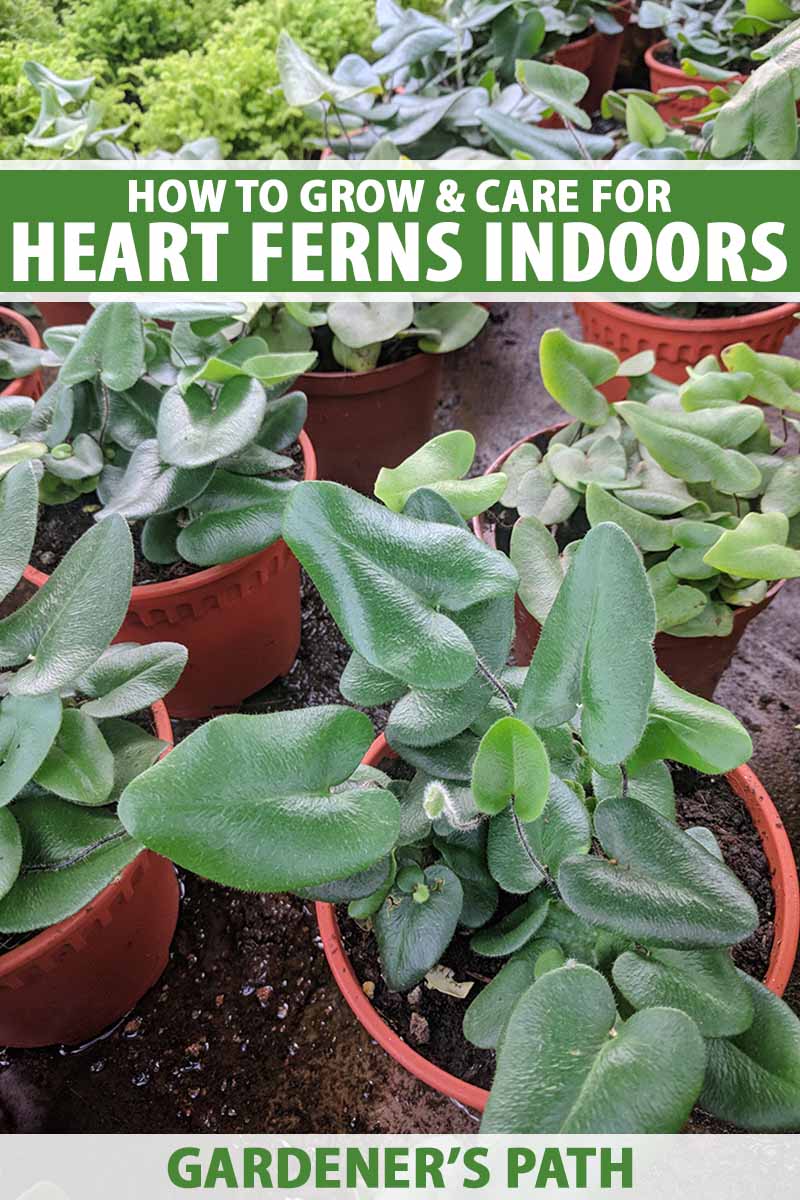
We link to vendors to help you find relevant products. If you buy from one of our links, we may earn a commission.
Whether you’re acquiring this beauty for yourself, or for someone else as a not-so-subtle declaration of romantic feelings, the heart fern is an amazing plant to add to your collection.
Plus, its cordate foliage is so striking that it would make an Eastern redbud jealous.
Read on to unlock this plant’s cultivation secrets for yourself! Here’s what’s coming, up ahead:
What You’ll Learn
Cultivation and History
Along with its decorative uses, this plant has also been cultivated for functional purposes. In parts of Asia, H. arifolia has been used to treat certain types of cancer and diabetes.
In animal trials, heart fern extracts actually lowered the blood glucose levels of sugar-fed rats! Whether or not this has actual clinical significance in humans remains to be seen, despite years of Asian folklore backing up its efficacy.
Like a newborn’s indecisive parents, the first individuals to describe H. arifolia couldn’t settle on a single name for a while.
Carl Linnaeus, a Swedish botanist who formalized binomial nomenclature for naming organisms, first described this species in 1753 as Acrostichum aureum. In the years to come, this name was replaced many times.
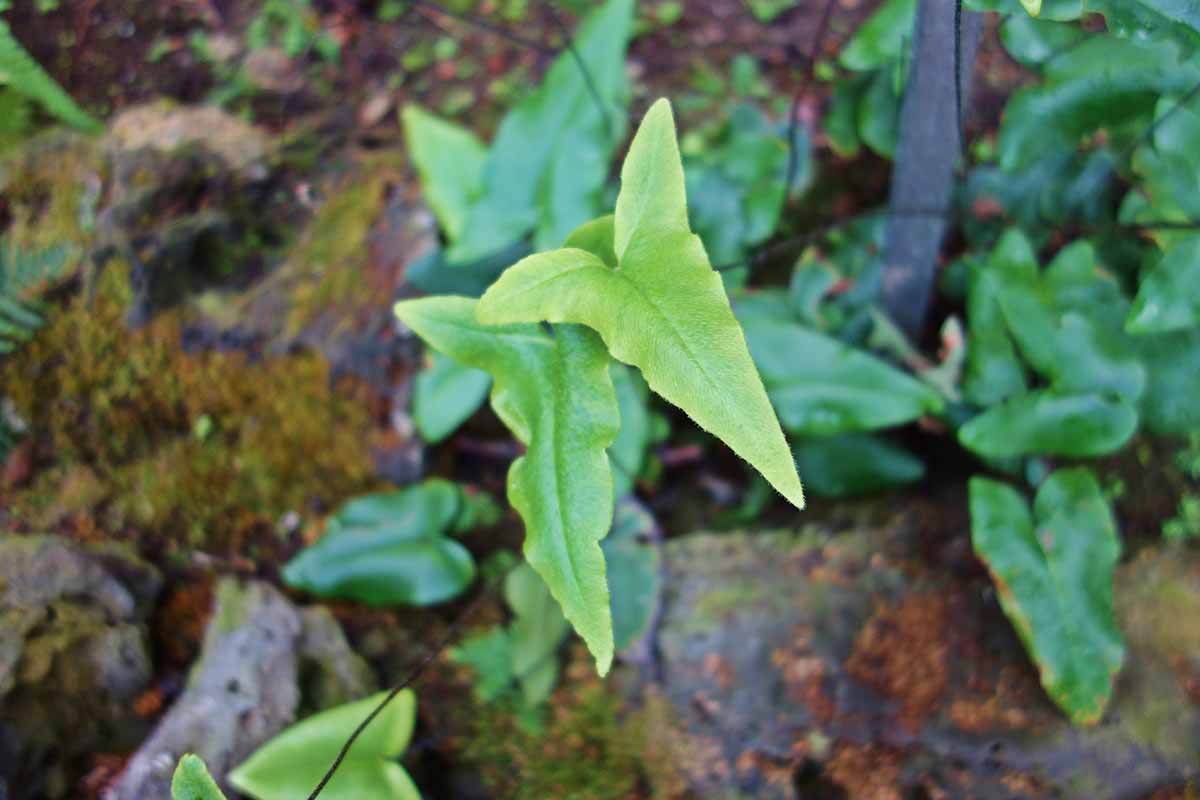
The plant finally received the name Hemionitis arifolia in 1859 from Thomas Moore, a renowned pteridophyte botanist from the British Isles.
He named it during the Pteridomania – or Fern-Fever – period of the Victorian era, a time of great fern obsession when everyone was collecting ferns and decorating things with fronded patterns.
Rumors that fern collecting showcased intelligence and increased virility only added to the hype, and Victorians of all social classes came to be avid collectors.
Because these plants were believed to be sterile, Hemionitis came from the Greek term for “mule” (hemionos), another sterile species. The term arifolia was selected because of this plant’s similar leaf shape to members of the Arum genus of plants.
Despite H. arifolia being the standardized name nowadays, A. aureum is also accepted as a synonymous name for the heart fern.
Propagation
Ferns don’t reproduce via seeds, but by producing spores. The heart fern is no exception. If you want to propagate an H. arifolia, then you’ve got two options: growing from spores, or division.
From Spores
If you’re up for a challenge, then growing spores is for you.
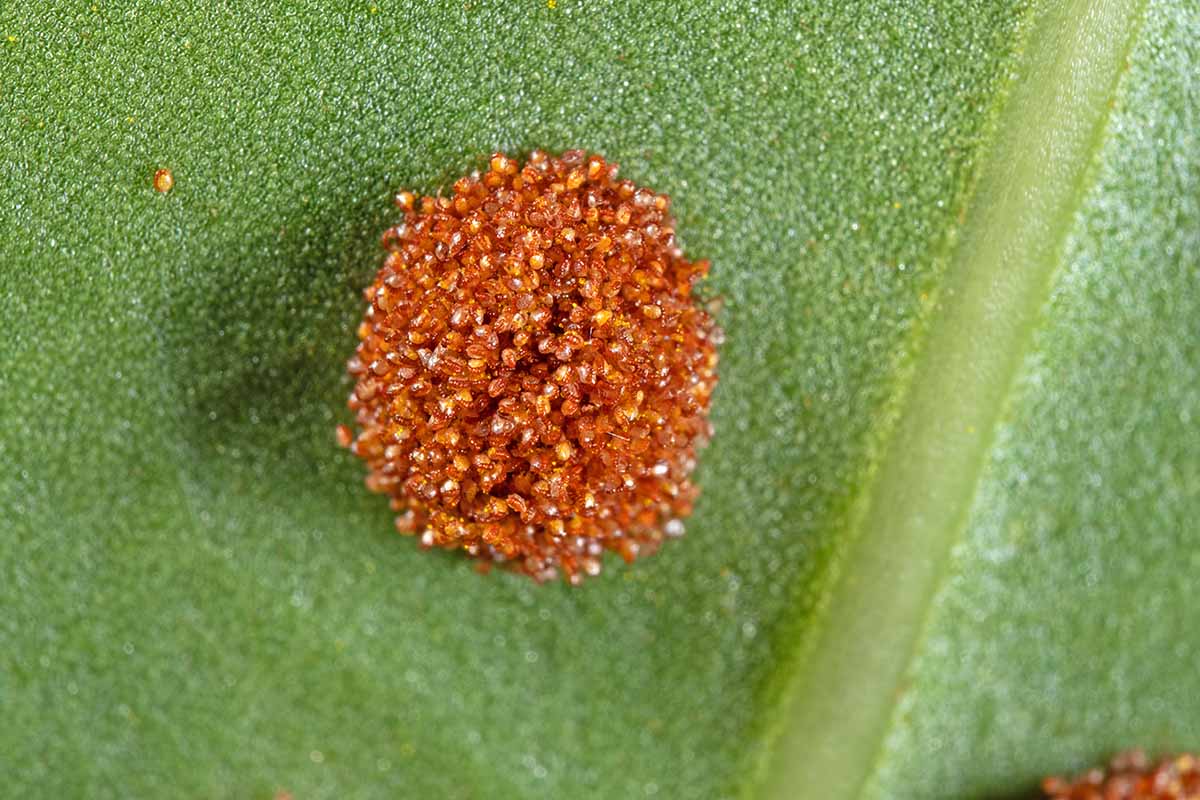
First, you’ll need a six-inch pot with drainage holes at the bottom. Fill the pot with a soilless medium that offers an even mix of aeration and water retention. Your typical “houseplant” mix will do fine here.
Next, you’ll want to remove a mature leaf or two when their undersides begin to sport browned and crispy spores.
Keep these leaves in a plastic baggie at room temperature until they dry and drop the spores. Take the dropped spores and sprinkle them over the surface of the potting mix.
You can also remove the spores manually with your hands. If they’re too small to be removed by hand, you can lay the foliage spores-down over the potting medium and allow the spores to settle in as they naturally drop from the fronds.
Throughout this whole process, keep the soil moist via misting and cover the pots with plastic.
It’s important to keep the fronds dry, so remove the fronds when you mist if you’re letting gravity do the sowing for you. When the majority of the spores drop from the fronds, said fronds can be discarded.
Germination takes up to two months, but wait until month five before pitching the lot and starting over.
The spores will grow into reproductive structures known as prothalli that will later form actual fern plants. When you’re left with small fern plants – two to three inches tall, max – then it’s time to move each one to its own pot.
Via Division
Dividing is a lot easier than cultivating spores, but it does hinge on having a large enough specimen to divide in the first place.
Spring is the ideal time to divide, when growth rates are at their peak. Feel free to multitask by dividing while you’re also repotting!
Prior to dividing, moisten the soil in both the old and the new pots.
To divide, gently loosen the soil, remove the heart fern, and cut the root ball in half. Be sure to leave an even amount of fronds intact for each half, along with proportionate roots to support the shoots.
If you want, repeat the process with each half to create a total of four daughter plants. As long as you start with a parent of substantial size to ensure that each of the four daughter plants won’t be too wispy, they should transplant nicely.
When you’re finished, transplant each into its own proportionally-sized pot as described below, and presto! You’re done!
Transplanting
Maybe the time required for propagation isn’t ideal, and you need a heart fern ASAP. Or maybe you don’t have a mother plant to propagate from. Either way, transplanting a live H. arifolia from the nursery is your best bet.
The following transplanting instructions apply for plants you’ve propagated yourself as well!
When it comes time to transplant, find a pot that’s large enough without being so large that the soil used to fill it might hold excess, disease-promoting moisture. Preferably, you’ll select a plastic container over terra cotta, which dries out more quickly.
Fill it with a 50-50 mix of sand and a moisture-retaining substrate such as peat moss or coconut coir.
Dig out a hole that’s large enough for the transplant’s root system. Place the roots in the hole and cover. Water in the plant to secure it in place and moisten the soil.
We have more detailed tips in our fern propagation guide.
How to Grow
First things first, you need to establish where you’ll put your plant. Because heart ferns are epiphytic, they don’t technically need to be planted in soil. They can just grow and develop while adhering to surfaces like an adolescent Spider-Man.
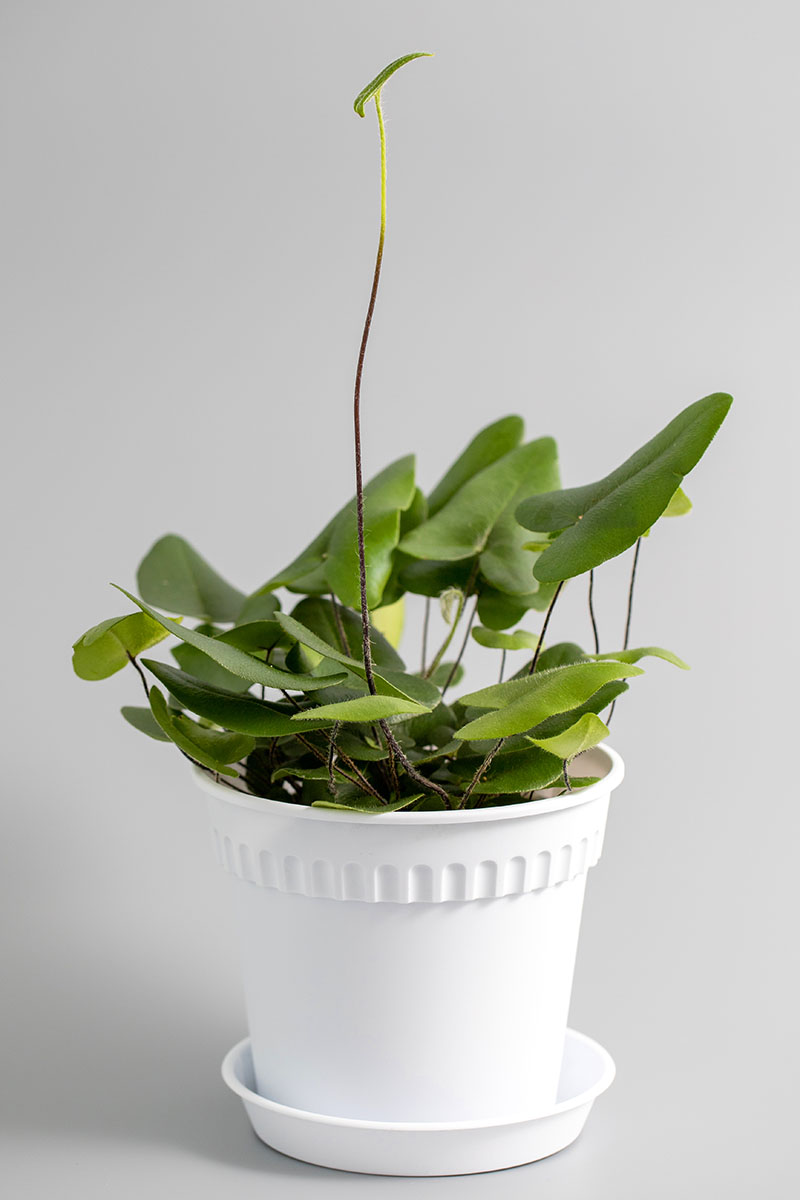
In the wild, H. arifolia would be growing on tree bark or a mossy rock, so a moss-covered base of support must be provided.
Deadwood, cork, or stone are some great choices. Peat moss is ideal for its high acidity, although coconut coir is an acceptable substitute.
Once you’ve chosen your base and growing substrate, attach the substrate to the base with staples, fishing wire, or glue.
Then anchor your H. arifolia by the stems to the substrate-covered base using jute, twine, or fishing wire. Feel free to remove a couple leaves if it’s too heavy to stay anchored.
H. arifolia can grow in soil as well. But because of the plant’s epiphytic nature, the planting medium must be light and loose around the roots.
Giving each heart fern its own pot that’s filled with a 50-50 mixture of sand and coconut coir, orchid bark, or peat moss should do the trick.
Whether you select a substrate with or without soil, the pH should err towards acidity if possible. But this fern’s pH tolerance is surprisingly flexible, so don’t worry if the pH is neutral or even a bit alkaline.
Next up, climate. In the wild, H. arifolia lives in the tropics under the shade of canopy trees, so this environment must be recreated indoors to the best of your ability. Specifically, this means temperatures ranging from 60 to 85° F, 60 to 90 percent humidity, and strong indirect lighting from nearby windows.
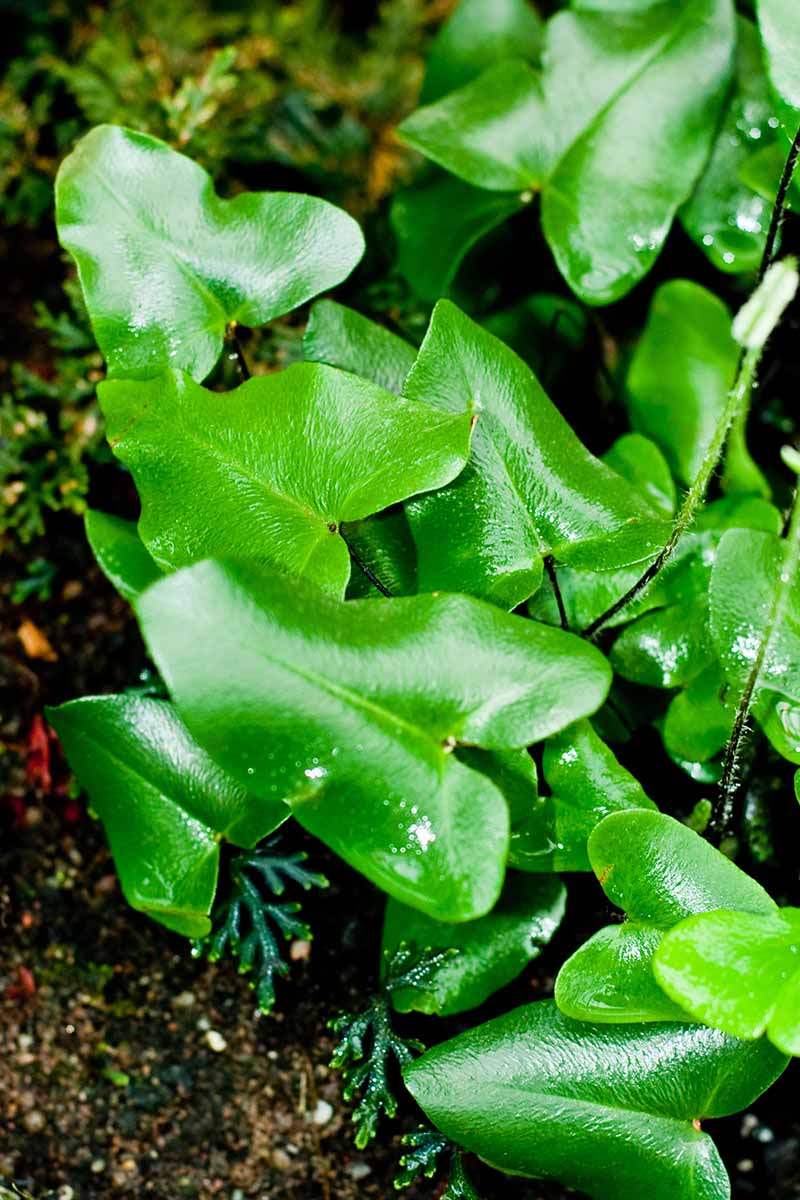
Humidity can be increased by using a humidifier or pebble tray, and grouping plants close together so their unified evapotranspiration keeps the nearby air humid.
Keep light indirect by placing your H. arifolia within six feet of an east-facing window, where it can get morning sun and avoid harsher afternoon rays. If brightly lit spots are all that’s available, sheer curtains placed over nearby windows can lower the light intensity.
H. arifolia needs its substrate to be kept moist at all times. Too little water will cause leaves to turn gray, develop brown patches, and get crispy. Too much water will cause yellow leaves and root rot.
To hit that middle ground, Goldilocks, “just right” amount of aqua: hold off on watering until the substrate’s top third is dry. But be diligent, because the heart fern isn’t all that tough. Withholding or overdoing it on the water for even a day will cause plant deterioration, so stay on top of your irrigation.
Hard water is pretty rough on H. arifolia, so collecting rainwater or filtering your tap water for irrigation would be ideal.
If installing a filtration system or splurging for a Brita pitcher ain’t your speed, then boiling should soften it up enough to use on the heart fern. Just be sure to allow it to cool completely before watering.
H. arifolia doesn’t need all that much fertilizer, as is the case with most ferns. A general all-purpose, balanced houseplant fertilizer diluted to half strength should suffice.
Apply a dose once a month during spring and summer, and none at all during the fall and winter.
Growing Tips
- Giving your pots/bases a quarter turn each day when possible can ensure even, all-around growth.
- To fertilize heart ferns that you’re growing without soil, use a foliar fertilizer instead.
- Heart ferns are sensitive to hard water, so use rainwater or filtered tap water instead, or boil and cool tap water prior to use.
Maintenance
In general, H. arifolia is a pretty low-maintenance clump of greenery. But pruning leaves when they’re brown, chlorotic, damaged, and/or diseased is a good idea. Be sure to use sterilized cutting implements to prevent disease.

Heart ferns don’t mind being root-bound, so you can take your time in repotting when they begin to outgrow their containers. If repotting on a regular schedule is more your speed, simply wait to do it once every two years maximum.
Where to Buy
So, you gotta buy a live heart fern?
Luckily enough BubbleBlooms has them available on Amazon, featuring all of the qualities of H. arifolia that you’ve grown to love, to boot, in a pot that measures four inches across.

These plants are somewhat difficult to find in physical stores, so your best bet would be to start looking in specialty houseplant shops with an emphasis in tropical specimens, rather than large nurseries or garden centers that might overlook the humble heart fern.
In addition, you could try plant trade shows or conventions to see if you can get an H. arifolia directly from a seller or fellow plant parent.
Who knows, these meet-ups could lead to a new friendship… or maybe even finding that special someone. With the heart fern’s cordate foliage, the opportunities for flirtatious banter and witty wooing abound.
Managing Pests and Disease
The warm, humid, and wet tropics that the heart fern naturally calls home are full of various creepy-crawlies and disease pathogens.
Despite growing in a (hopefully) more sterile environment, domesticated H. arifolia are prone to certain bugs and disease. As always, prevention is better than cure.
Insects
Since insects can be vectors for pathogens, managing them can simultaneously keep disease in check!
Aphids
Aphids are light green, soft-bodied insects that tend to blend in with most foliage. They should be easier to spot than usual on the dark green foliage of H. arifolia, though.
Aphids will consume the soft and juvenile parts of the plant, secreting honeydew in their wake that can itself be a vector for disease.
A spray of garlic water directly on the aphids or a spray of neem oil to the infested plant parts can help.
Need neem oil? Bonide has a ready-to-use product, available from Arbico Organics.
Mealybugs
Mealybugs show up as white, cotton-looking clumps on fronds, leaf axils, and roots. Mealybugs can cause stunted growth and eventual necrosis of infested plant tissues.
Drench the soil with an insecticide like this pyrethrin concentrate from PyGanic Gardening, available via Amazon in eight-ounce containers.

Make sure you dilute the concentrate in accordance with the instructions.
Growing without soil? A gentle spray of water or organic insecticidal soap to the foliage will help with mealybug control without causing damage to the sensitive fronds.
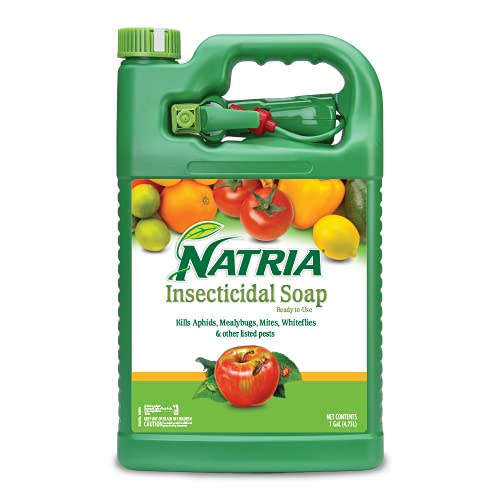
Natria has a great product for this that’s available from Amazon.
Scale
Scale can be tough to spot. These brown, teensy-weensy bugs can blend into the foliage, effectively putting them in stealth mode. Infested plants may become weak, stunted, or even necrotic.
Controlling scale is identical to dealing with mealybugs: apply an insecticide to the soil and let it drain. If your heart fern is growing sans soil, a foliar spray of insecticidal soap like the one mentioned above will get the job done.
Disease
As a general rule, the use of sterile pots, soil, bases, and tools can all help to prevent disease spread.
Just in case, be on alert for the following:
Powdery Mildew
The tragic thing about powdery mildew is that it’s often prevalent in shade and high humidity, among closely grouped plants – all of which we intentionally subject our heart ferns to, funnily enough.
This disease shows up as a dusty whitish-gray coating on foliar surfaces. Initially, powdery mildew can be rubbed off the leaves by hand, but this is rarely a viable long-term solution. Removing and destroying infested fronds is a good initial step.
Longer-term solutions include spraying with fungicide, reducing excess humidity, and improving overall air circulation.
Root Rot
Root rot symptoms include severe wilting, rapid foliar chlorosis, stunted or no growth, and rotted root systems. This not only harms your plant, but will hinder the collection of vital nutrients by the roots in the future.
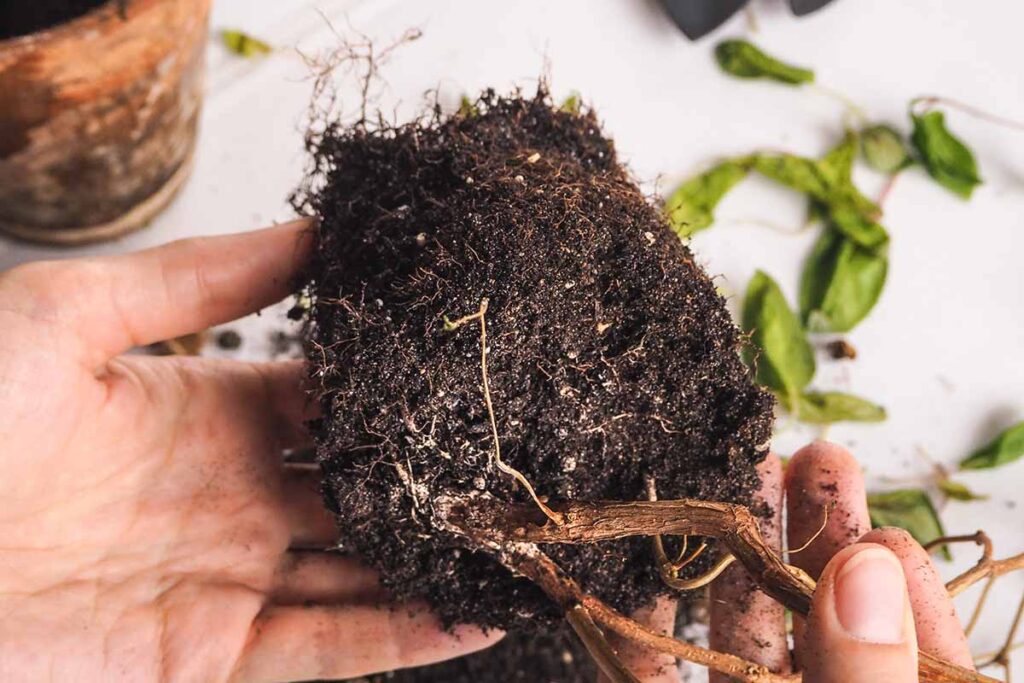
To treat this, take the plant out of its container or remove it from its substrate, and have a gander at the root ball. Remove any diseased roots and replace the substrate with a newer, sterile substrate that’s free of pathogens.
Ensure that any excess watering that might have caused this disease won’t occur again in the future.
Learn more about treating root rot here.
Southern Blight
This is a lethal fungal disease caused by Sclerofium rolfsii that often occurs in the tropics. Since we’re recreating tropical conditions for our H. arifolia, this is cause for concern.
This pathogen gives plant tissues closer to the soil line a water-soaked appearance, and leaves plants prone to secondary ailments such as rots.
There’s not much to do that will cure this disease. Your best bet is to dispose of infected plant parts and adjacent substrate, and start over with sterile material.
When it comes to southern blight, prevention via proper watering and sterile growing conditions IS the cure.
Best Uses
The heart fern does well as a small specimen houseplant, an accessory to other houseplants, or as an ingredient in terrariums or vivariums.

Its semi-compact size makes it ideal for fitting in those tight spaces that your other, larger houseplants won’t squeeze into. The epiphytic nature of these plants also make them ideal for display via mounting, sans soil.
This is also a great conversation starter for those awkward moments with houseguests when no one quite knows what to say next!
Quick Reference Growing Guide
| Plant Type: | Evergreen epiphyte | Foliage Color: | Dark green |
| Native to: | Tropics of Southeast Asia | Tolerance: | Moist and acidic mediums |
| Hardiness (USDA Zone): | 10-12 | Soil Type: | Moist, rich, loosely-packed |
| Exposure: | Indirect sunlight or shade, high humidity | Soil pH: | 5.0-8.0 |
| Time to Maturity: | 5-8 years | Soil Drainage: | Well-draining |
| Height: | Up to 1 foot | Uses: | Medicinal, interior decor |
| Spread: | Up to 1 foot | Order: | Polypodiales |
| Water Needs: | Moderate | Family: | Pteridaceae |
| Maintenance | Moderate | Genus: | Hemionitis |
| Common Pests and Diseases: | Aphids, mealybugs, scale; powdery mildew, root rot, southern blight | Species: | Arifolia |
Pteridophyte Puns: Ain’t They Ferny?
Hopefully, you’ve come to “heart” Hemionitis arifolia as a great addition to your ever-growing houseplant collection.

I won’t lie to you. This plant involves a wee bit of sacrifice.
You’ll need to keep a constant eye out for dryness, disease, and pests. The quest for perfect humidity will never be complete, and your thermostat might be set higher than your utilities-conscious father raised you to be comfortable with.
That last one may have gotten a bit personal… I digress.
But after all that, you’ll be left with a beautiful pteridophyte that makes a statement. A statement that roughly translates to: “I can grow this wickedly awesome plant, and the work ethic and competence required to do so will surely bleed over into the rest of my life.” And isn’t that what this plant hobby of ours is all about?
Have experiences with the heart fern? Left with burning questions? Share them in the comments section below!
Want similar growing guides? Then have yourself a look-see at these here articles next:

Awesome article! I love this fern. I found it in my local grocery store and it looked like it needed a new home!
Thanks Joe for all the great info on this one!